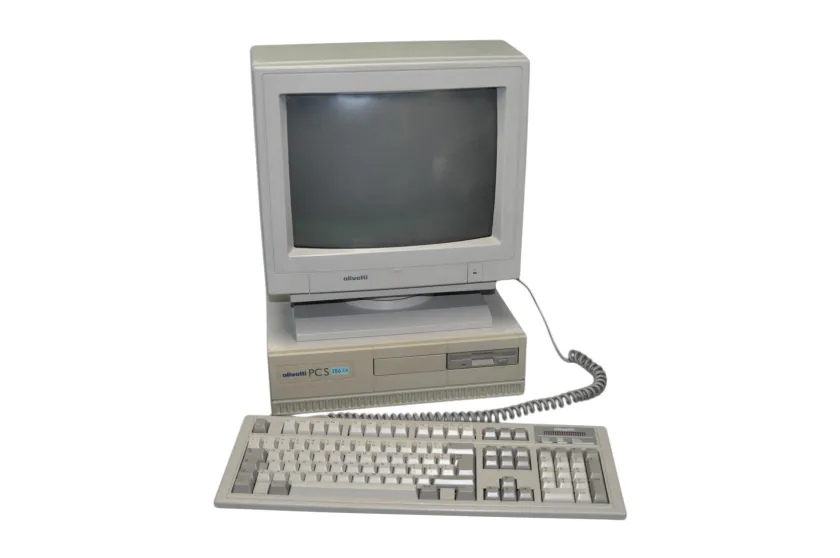Permettete ai bambini di giocare con la tecnologia! Soprattutto: incoraggiateli a giocarci in maniera consapevole, non soltanto utilizzandola, ma guardando sotto al cofano per cercare di capire i come ed i perché.
È una cosa che ho sempre saputo, ma che ho realizzato compiutamente solo di recente. Stavo chiacchierando con Joseph Amodio per questo articolo riguardo a disinformazione, misinformazione e cybersicurezza, commentando i risultati del nostro studio pubblicato in giugno. Ed ho realizzato quanto il mio primo computer abbia influenzato non tanto la mia carriera, quanto il mio modo di pensare.
Nel 1993 (avevo sei anni) mio padre portò a casa un (allora modernissimo) Olivetti PCS386SX – 16 MHz di clock, 2 MB di ram, 40 MB di disco. Fa ridere, confrontato con le specifiche hardware di oggi. E fa pensare, perché mio padre non era un informatico, ma un calzolaio; un computer in casa era cosa tutt’altro che comune, e men che meno per gente della nostra estrazione.
Ma su quella macchina, oltre a windows 3.1, girava MS-DOS 6. La mia prima riga di comando. E quella versione di MS-DOS includeva QBasic, che a leggerlo oggi sembra un linguaggio di programmazione uscito da un incubo (GOTO e proliferazione delle linee…), ma hey, era un linguaggio di programmazione! Perché dovrei calcolare a mano i minimi comuni multipli ed i massimi comuni denominatori di coppie di numeri, quando posso scrivere del codice che lo faccia al posto mio?
C’era anche qualche videogioco su quel PC – Prehistorik 2, Prince of Persia, quel genere di giochi – ma francamente non ho mai superato il secondo livello di Prince of Persia ed il quarto di Prehistorik 2. Mi interessavano e mi affascinavano molto meno del codice. “Perché limitarmi ad usare il codice che ha scritto qualcun altro” mi dicevo “quando invece posso scrivere il mio? Certo, non sarà così figo e colorato e con le musichette, ma è il mio. So cosa fa, so come lo fa, e so perché”.
La storia proseguirebbe poi con i primi frustrantissimi esperimenti con Debian (installare e configurare Debian nel 1998 – avevo 11 anni, nessun LUG a portata di mano, e le connessioni dial-up costavano come il fuoco), numerosi fallimenti, qualche successo, e Bash, e Python, e tanto, tanto, tantissimo tinkering, anche quando i miei interessi cognitivi si sono formalizzati ed hanno preso la direzione della filosofia anziché quella dell’informatica.
Ma tutto questo è una conseguenza, più che una causa: la causa è quella scelta di mio padre di mettermi in mano un computer, una riga di comando, ed un linguaggio di programmazione. Quindi: Permettete ai bambini di giocare con la tecnologia! Soprattutto: incoraggiateli a giocarci in maniera consapevole, non soltanto utilizzandola, ma guardando sotto al cofano per cercare di capire i come ed i perché.
Allow children to play with technology! Above all: encourage them to play with it consciously, not just using it, but looking under the hood to try to understand the hows and whys.
This is something I have always known, but only recently realized fully. I was chatting with Joseph Amodio for this article about disinformation, misinformation and cybersecurity, commenting on the results of our study published in June. And I realized how much my first computer influenced not so much my career as my way of thinking.
In 1993 (I was six years old) my father brought home a (then very modern) Olivetti PCS386SX – 16 MHz clock, 8 MB ram, 40 MB of disk memory. It makes one laugh, compared to today’s hardware specifications. And it makes you think, because my father was not a computer scientist, but a shoemaker; a computer at home was anything but common, much less for people of our background.
But on that machine, in addition to Windows 3.1, MS-DOS 6 was running. My first command line. And that version of MS-DOS included QBasic, which today sounds like a programming language out of a nightmare (GOTO and line proliferation…), but hey, it was a programming language! Why would I have to calculate the lowest common multiples and highest common denominators of pairs of numbers by hand, when I could write code that would do it for me?
There were also a few video games on that PC – Prehistorik 2, Prince of Persia, those kinds of games – but frankly I never got past the second level of Prince of Persia and the fourth level of Prehistorik 2. They interested and fascinated me much less than the code. “Why limit myself to using code that someone else has written,” I used to say to myself, “when I can write my own instead? Sure, it’s not going to be as cool and colorful and with musics, but it’s my own. I know what it does, I know how it does it, and I know why.”
The story would then continue with the very frustrating early experiments with Debian (installing and configuring Debian in 1998 – I was 11 years old, no LUG at hand, and dial-up connections cost like fire), numerous failures, some successes, and Bash, and Python, and lots and lots and lots of tinkering, even as my cognitive interests became more formalized and took the direction of philosophy instead of computer science.
But all this is a consequence rather than a cause: the cause is that choice of my father to put a computer, a command line, and a programming language in my hand. So: Allow children to play with technology! Above all: encourage them to play with it consciously, not just by using it, but by looking under the hood to try to understand the hows and whys.

